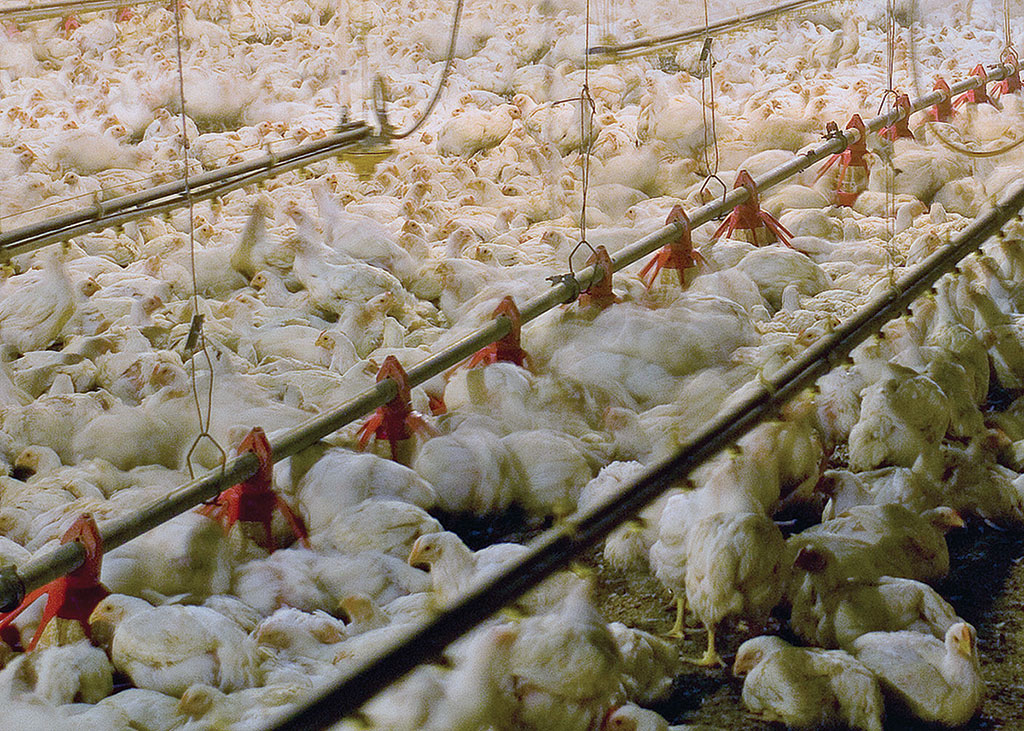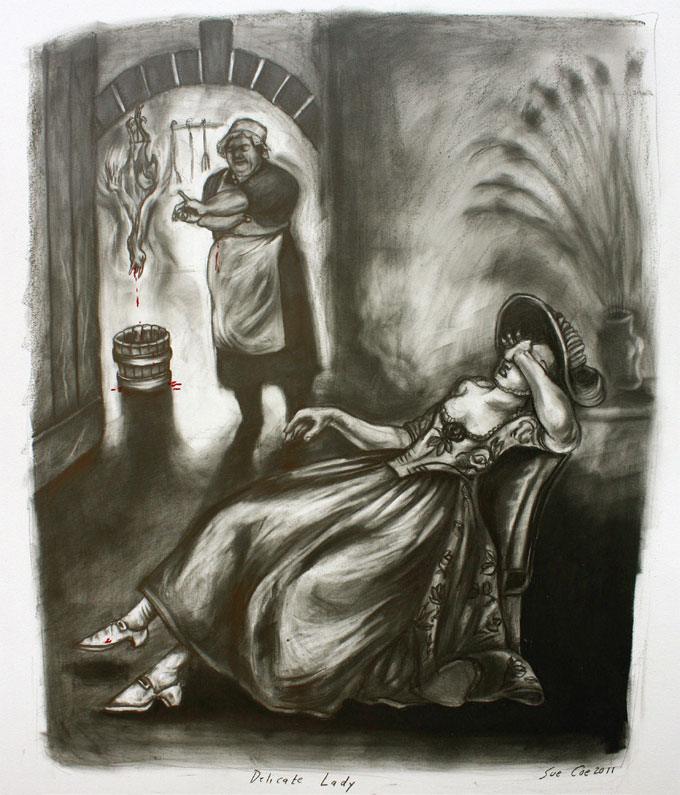Regarding the Pain of Farmed Animals
By Karen Davis, PhD, President of United Poultry Concerns
In May this year I suffered a fall that required emergency spinal surgery followed by a lengthy stay in a rehabilitation facility, from June 4 to July 23, in Nassawadox, Virginia, five miles up the road from Machipongo where we are headquartered with our chicken sanctuary. For decades I’ve been preoccupied with pain – not my pain, which never amounted to much until now, but rather with the unrelieved and untreated pain of the countless chickens, turkeys, and other animals living in what, in the twentieth century, became factory farms.

Perdue chicken factory farm. Photo by David Harp.
Factory farms are places in which large numbers of genetically and chemically manipulated animals are warehoused to grow into food for human consumption. In these places, animals are mired in the squalor that results when groups of creatures of any species are crowded together in accumulating waste. We now know that these animals are not only forcibly confined in environmental filth including toxic gases, but that they are caged in bodies wracked with painful deformities and diseases inflicted on them by human beings. They are locked into what the twentieth-century animal rights activist Henry Spira referred to as “the universe of pain and suffering” from which there is no escape but in death.
By “we,” I mean those of us in the animal advocacy movement who focus particularly on the plight of farmed animals and who track the evidence reported by agribusiness researchers specializing in farmed animal “diseases of production” and “welfare.” For example, in “Pain in Birds,” animal scientist Michael Gentle writes that the “widespread chronic orthopedic disease in domestic poultry,” added to the fact that there is a “wide variety of receptors in the joint capsule of the chicken,” including pain receptors, supports the behavioral evidence that the birds are in chronic pain.
In 1990, the American Association of Avian Pathologists identified three of the most common bone pathologies associated with the forced rapid growth of present day poultry: Angular bone deformities, in which the bones become bowed in or out or twisted; tibial dyschondroplasia, in which the bones develop fractures and fissures; and spondylothesis, in which the vertebra become dislocated and/or cartilage proliferates in the lower backbone, pinching on the spinal cord and lower back nerves.
For all of these tortures, no pain relief is offered. Having been in a “pain management” program since May following my spinal surgery, I both can and cannot imagine the unrelieved suffering of these birds. I think about their suffering in its own right and also in terms of our society’s expectation of immediate pharmaceutical relief for everything from mild depression to minor stomach upset.
Before Factory Farms
In his book Animal Revolution, Richard Ryder (who coined the term “speciesism”) offers a glimpse of how animals were prepared for meals in the typical 18th-century English household during the Age of Enlightenment. Alexander Pope, the great English poet of the time, described “kitchens covered with blood and filled with the cries of creatures expiring in tortures.”
Many people believe that the pre-factory-farming era was idyllic, or nearly so, for chickens, turkeys, and other farmed animals. In reality, factory farming is an extension of age-old attitudes and practices toward animals raised for food. For example, Keith Thomas, in Man and the Natural World, observes that poultry and game birds in previous centuries “were often fattened in darkness and confinement, sometimes being blinded as well.”
Geese were thought to put on weight if the webs of their feet were nailed to the floor, and “it was the custom of some seventeenth-century housewives to cut the legs off living fowl in the belief that it made their flesh more tender.” The London poulterers, Thomas writes, “kept thousands of live birds in their cellars and attics” in conditions forecasting today’s factory farms.
In A Natural History of the Senses, Diane Ackerman describes culinary practices that arose in eighteenth-century England, when “bored city dwellers became fascinated by sadism,” including the idea that “torturing an animal made its meat healthier and better tasting.” One recipe starts out: “Take a red cock that is not too old and beat him to death.” Another instructs:
Take a goose, or a Duck, or some such lively creature pull off all her feathers, only the head and neck must be spared: then make a fire round about her, not too close to her, that the smoke do not choke her, and that the fire may not burn her too soon; not too far off, that she may not escape free: within the circle of the fire let there be set small cups and pots of water, wherein salt and honey are mingled; and let there be set also chargers full of sodden Apples, cut into small pieces in the dish. The Goose must be all larded, and basted over with butter: put then fire about her, but do not make too much haste, when as you see her begin to roast; for by walking about and flying here and there, being cooped in by the fire that stops her way out the unwearied Goose is kept in; she will fall to drink the water to quench her thirst, and cool her heart and all her body, and the Apple sauce will make her dung and cleanse and empty her. And when she roasteth, and consumes inwardly, always wet her head and heart with a wet sponge; and when you see her giddy with running, and begin to stumble, her heart wants moisture, and she is roasted enough. Take her up and set her before your guests and she will cry as you cut off any part from her and will be almost eaten up before she be dead: it is mighty pleasant to behold!
Eighteenth-and nineteenth-century literature offers additional testimony regarding the treatment of chickens and other domestic fowl. In Tobias Smollett’s novel The Expedition of Humphry Clinker, published in 1771, the Welsh traveler Matthew Bramble complains during a visit to London that “the poultry is all rotten, in consequence of a fever, occasioned by the infamous practice of sewing up the gut, that they may be the sooner fattened in coops, in consequence of this cruel retention.”
In order to whiten their flesh, calves, sheep, birds, and sometimes lambs, were stuck in the neck so that the blood would drain out slowly for hours and days. The wound would be stopped up and the animal would be left to linger alive for another day or so. In The Rural Life of England, William Howitt describes the practice of hanging live turkeys in the kitchen upside down by their heels to bleed out “through a vein opened under the tongue,” to improve their color. This is also how calves became veal prior to the adoption of the veal crate in the twentieth century – they were suspended upside down from the kitchen ceiling.

“Delicate” lady with dying turkey, by Sue Coe.
“Evolved” Animal Farming
The effects of the “human controlled evolution” of chickens and other birds bred for the meat industry are described in an article in International Hatchery Practice. Andrew A. Olkowski, DVM and his colleagues state in “Trends in developmental anomalies in contemporary broiler chickens” that chickens with extra legs and wings, missing eyes and beak deformities “can be found in practically every broiler flock,” where “a variety of health problems involving muscular, digestive, cardiovascular, integumentary, skeletal, and immune systems” form a complex of debilitating diseases. Poultry personnel, they say, provide “solid evidence that anatomical anomalies have become deep-rooted in the phenotype of contemporary broiler chickens.”
An example is a breast muscle myopathy described in 2018 as a worldwide phenomenon. Called “wooden breast,” this condition manifests a manmade impairment in “broiler” chickens so severe that the birds’ breasts develop a hard wood-like texture involving necrosis, fibrosis, and macrophage infiltration relating to the cardiopulmonary system’s inability to supply capillary blood to the bird’s massively growing breast muscle, which as a result hardens and dies.
Ulcerative and necrotic diseases in agribusiness chickens are endemic. Femoral head necrosis occurs when the top of the leg bone disintegrates as a result of bacterial infection, oppressive body weight, and oxygen deficiency in the contaminated chicken houses that exacerbate the birds’ pre-existing pulmonary pathologies. Necrotic enteritis involving the bacterial agent Clostridium perfringens shows intestines swollen with gas, oozing putrid fluid, and full of ulcers. Gangrenous dermatitis, a skin disease, affects the legs, wings, breast, vent, abdomen and intestines of the birds as a result of toxins emitted by Clostridium perfringens in conjunction with exposure to immunosuppressive viruses in the chicken sheds.
Pain Without Pity
The idea of a past characterized by compassionate animal farming that could be revived and modernized in contrast to factory farming does not pass scrutiny. Industrialized animal production practices reflect the inveterate view that, as poultry researcher Joy Mench once told me in the comfort of her office, the basic premise of our relationship with “food” animals precludes ethics and empathy. It allows us to decide that morality does not apply to our use of these animals. Traditional animal husbandry practices support this nihilistic viewpoint.
A photograph of turkeys being “noodled” (force-fed) to increase the size and growth rates of their livers and bodies, appears in the March 1930 issue of the National Geographic, along with much else that helps to explain why a sixteenth-century observer wrote of animals raised for food: “They feed in pain, lie in pain, and sleep in pain.” Farmed animals live and die in lonely, relentless agony that even pain-relieving medication could not overcome. We may think that roasting a live bird in front of a fire and devouring her while she is dying is too cruel and savage for today’s world, but nothing could be further from the truth.
KAREN DAVIS, PhD is the President and Founder of United Poultry Concerns, a nonprofit organization that promotes the compassionate and respectful treatment of domestic fowl including a sanctuary for chickens in Virginia. Inducted into the National Animal Rights Hall of Fame for Outstanding Contributions to Animal Liberation, Karen is the author of numerous books, essays, articles and campaigns. Her latest book is For the Birds: From Exploitation to Liberation: Essays on Chickens, Turkeys, and Other Domesticated Fowl (Lantern Books, 2019).
Amazon Reviews Praise FOR THE BIRDS: FROM EXPLOITATION TO LIBERATION by Karen Davis, PhD
Don't just switch from beef to chicken. Go Vegan.
www.UPC-online.org


